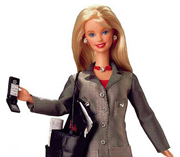 I loved my Barbie doll growing up in the sixties. My daughter loved HER Barbie doll growing up in the eighties (offers to play with Barbie were made to my sons as well, but they weren’t interested). Did I fail to live up to my excellent feminist college education in the seventies by not banning Barbie from my home?
I loved my Barbie doll growing up in the sixties. My daughter loved HER Barbie doll growing up in the eighties (offers to play with Barbie were made to my sons as well, but they weren’t interested). Did I fail to live up to my excellent feminist college education in the seventies by not banning Barbie from my home?
Author Sloane Crosley*, in the following article from Smithsonian Magazine, suggests that it’s time we cut Barbie some slack, and asks whether the doll really represents such a menace to society.
* * *
She’s wearing entirely too much eyeliner. When the Mattel company introduced Barbie to the world, in 1959, she wore a black-and-white striped one-piece bathing suit, black heels, white sunglasses and… entirely too much eyeliner. The makeup was no doubt applied because Barbie was meant to be older than traditional dolls marketed to preteens. Here, at long last, was a modern gal who could hold down a job, date and drive. Of course, despite these life skills, Barbie’s most consistent feat turned out to be stirring up controversy.
One Barbie doll is sold every three seconds somewhere in the world. No one that popular is universally adored. Barbie has long drawn criticism for her unrealistic — nay, fatal, if applied to any human counterpart — proportions as well as her role as Forewoman of the Gender Stereotype Factory. In addition to plastic combs and hand mirrors, she comes with a litany of feminist faux pas. As recently as 1991, Barbie pronounced, via a small speaker embedded in her abdomen, that “math class is tough” and “party dresses are fun.”
The following year brought the best-selling Barbie doll of all time, Totally Hair Barbie. Hair she tied back when she appeared in the exercise tape “Dance! Workout With Barbie!” This, even though Barbie, being a doll, has little need for cardio, and impressionable preteen girls already dying to look like the models they see in magazines have even less for it.
But 20 years later, is Barbie really such a menace to society? Or is she an institution of plastic Americana, a blank slate on which we’ve superimposed half the population’s challenges? As an American woman (a child of the mid-’80s, I was weaned on Barbie and the Rockers), I have officially decided to cut Barbie a little slack. Terrible makeup and all.
We live in a world where Barbie is no longer forced to shoulder the burden of American female self-esteem by herself, just as G.I. Joe can no longer be faulted for promoting youth violence when there’s a computer and an Xbox at hand. Good old Barbie seems relatively harmless compared with, say, the entire catalog of reality television.
There is something incredibly appealing about Barbie’s size (not her proportions, mind you) to the animated hand of a little girl during playtime. You can get a real grip on Barbie, safe in the knowledge that she won’t slump over as you bob her back and forth in conversation. And those conversations, especially concerning Ken, can get heated. I remember getting so irate with a friend’s Barbie during a play date that I had my Barbie march off, jump into her Barbie Corvette, put her webbed foot on the gas pedal and drive straight to the living room. Try doing that with an American Girl or a Polly Pocket. For all of Barbie’s girly reputation, she’s built for real emotions, for backyard adventures and roughhousing.
Also to her credit? Math wouldn’t always be tough. The woman has managed to hold down over 130 careers. Besides the aerobics instructing and lifeguarding, she has also been an astronaut, a presidential candidate, an architect, an engineer, a doctor and a paleontologist. Sure, her longest-standing career has been that of fashion model, but you try having the same job for five decades and see if you don’t start dabbling in firefighting and dentistry.
Ultimately, half the fun of Barbie is imagining her as a single woman with all these careers, a filter for the changing desires of girls, even if Barbie’s progressive accomplishments are just as unrealistic as her antiquated ones. No woman has those hips and that rib cage, and no woman has designed an airplane and piloted it while simultaneously serving drinks and snacks in the main cabin. Though I suppose if anyone could do it, Barbie could.
* * *
* Sloane Crosley is the author of two best-selling collections of essays, I Was Told There’d Be Cake and How Did You Get This Number. Her first novel, The Clasp, will be published in 2015.